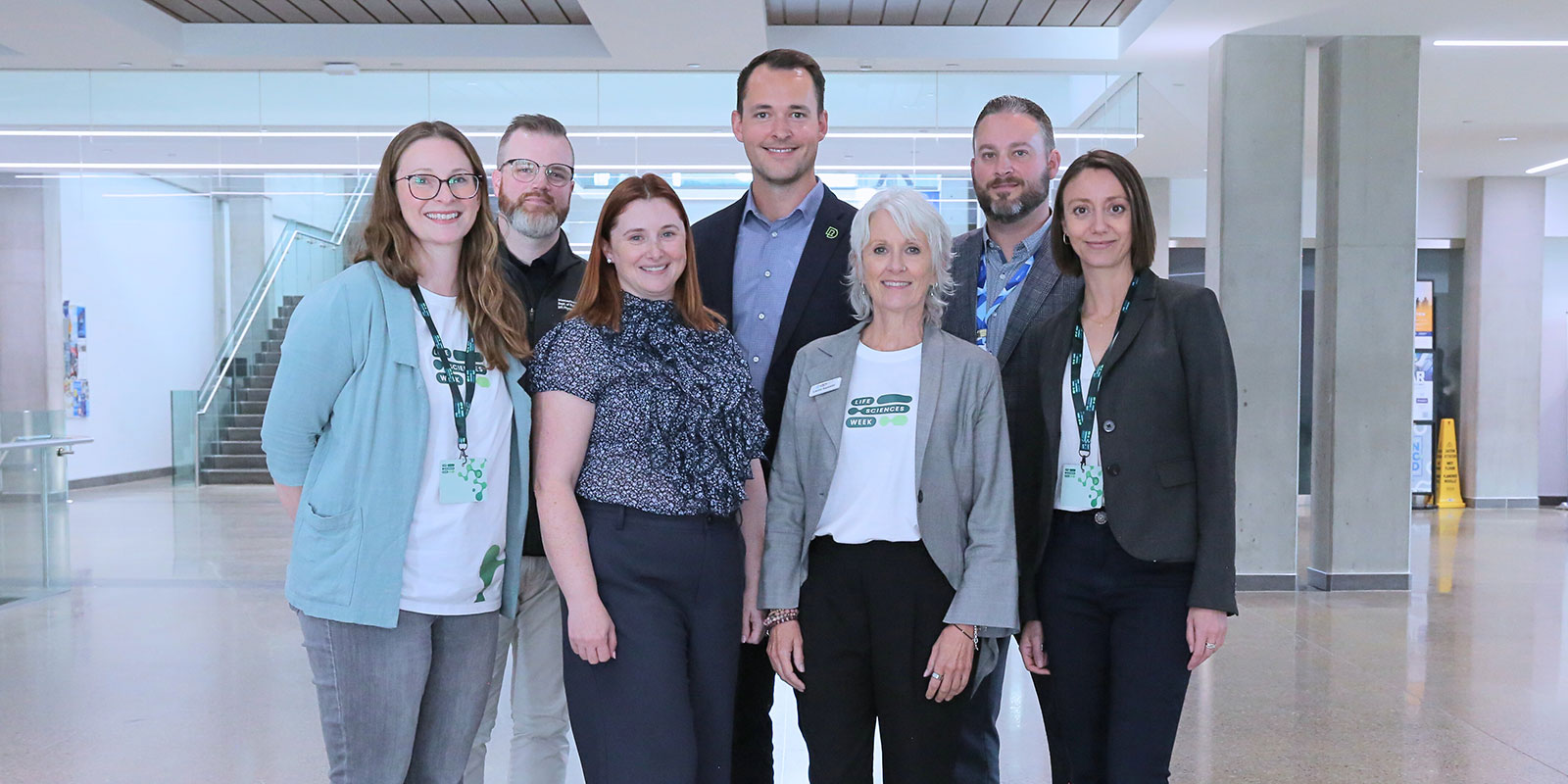Centre for Advanced Medical Simulation collaborating with four other Alberta organizations
One day, Karlene Haubrich (Bachelor of Technology in Management ’24) hopes to run her own tech company. It would manufacture and distribute a health-care device of her invention, or license it for production. Either way, it would play a role in patient care worldwide.
For now, however, the registered nurse has an idea.
Haubrich’s prototype, awaiting engineering and design, is inspired by her work with sufferers of respiratory ailments. Reluctant to reveal too much, she says it would continuously, inexpensively and noninvasively monitor oxygen disconnections that compromise patients and cost care facilities. Keeping with her passion for sustainability, it would be reusable, too.
Haubrich is well suited for the project. She’s run a business before, and holds a position at the Glenrose Rehabilitative Hospital helping small businesses develop their own health-care innovations. Haubrich cochairs a working group at MedTech Canada, a medical technology industry association. She consults nationally on respiratory device regulations.
Overall, Haubrich sees herself as working “at the intersection of innovation and health care.”
And yet, questions remain even for her: How exactly do you go from an idea, or even a prototype, to cracking a high-regulated – but US$556-billion – market?
That’s the issue the Medtech Innovation Highway Pilot Program was created this year to address, with NAIT’s Centre for Advanced Medical Simulation (CAMS) among its founding members.
Learn more about health innovation services offered by NAIT’s Centre for Advanced Medical Simulation
So many good ideas

This summer, Haubrich (above) was one of three early stage entrepreneurs to participate in a soft launch of the project.
“I’m like a guinea pig for the program,” she says, proudly.
The group – the first of its kind in Alberta – includes Applied Pharmaceutical Innovation to provide insight into regulations, business strategy expert CR Consulting, Parlee McLaws LLP to handle intellectual property matters, Red Deer Polytechnic for technical development, and CAMS, which will weigh in on testing and market fit.
The partnership was born of existing relationships and members’ knowledge of one another in Alberta’s innovation ecosystem. As of the official launch on Sept. 24, they’ll continue to complement each others’ skills in the six-month pilot to support entrepreneurs in a sector reported to account for 33% of Alberta’s life sciences industry.
“None of us do it all,” says CAMS director John Sutherland. “We’re stronger as a collaborative than we are as individual players.”
The group aims to help innovators navigate the path toward qualifying for funding from a program such as Alberta Innovate’s Accelerating Innovations into Care, as well as for other services from providers the Medtech program is working to identify. Janice Baskin, manager of the Edmonton Regional Innovation Network, describes that journey as “nebulous.”
Innovators in any industry will struggle to learn what steps to take and who to contact. “But the medical technology industry is unique in that there is extra friction because of the regulatory pathways,” says Baskin.
Haubrich knows this firsthand, having spent much of the previous year nudging her innovation forward on her own. “If someone had filled those gaps for me a little bit easier, maybe I would have gotten further faster,” she says.
Likely, that would have cost her – which is why the Medtech Innovation Highway is financially accessible. For $250, the group provides a single intake that connects entrepreneurs with the breadth of its expertise, ultimately providing clients with a roadmap-style report. If all goes well, a funded innovator may return to partner with the collaborative in further development.
“It surrounds the entrepreneur with that 360[-degree] assessment to set them up for success,” says Haubrich. As an adviser in the field herself, she sees that approach as essential to giving potential funders confidence and, over time, to helping the entire innovation community thrive.
“We need to be able to de-risk sooner and cheaper,” says Haubrich. “There are so many good ideas.”
An innovation powerhouse

When “powerhouse” organizations unite to help innovators overcome obstacles, “it’s kind of a big deal,” says Baskins. She sees CAMS as an emerging but already considerable contributor.
“I often call it the jewel of the innovation ecosystem that no one knows exists,” says Baskins. “It’s a tremendous facility.”
From her perspective, the program’s potential success will be two-fold.
One: it outgrows its pilot status, securing ongoing, sustainable funding that will allow the program to grow. Two: in the coming six months, about a dozen innovators see its benefits – with those eventually extending to clinics, hospitals and the lives of patients.
Haubrich, report now in hand as a soft launch participant, hopes to see that outcome for her own device. She admits she’s not sure exactly where the Medtech Innovation Highway will lead her – whether to build a company or take another promising side road. Either way, she’s encouraged by a sense of momentum.
“It’s one of those things that creates so many opportunities,” she says of the experience.
In the meantime, Haubrich feels that questions have been answered and a compass point has settled into place. Wherever she’s ultimately headed, she knows she’s a little closer.
The “navigator”: Key to a coordinated effort
At the centre of the collaboration between the five partners of the Medtech Innovation Highway will be an intern who will be supervised by CAMS. That person will serve as both “the glue to hold us together” and “a navigator,” says John Sutherland, CAMS director.
Supported by Mitacs, a not-for-profit organization dedicated to fostering innovation in Canada, and under the Life Sciences Placement Program at API, the intern will define and refine processes. They will map workflows between collaborators, adjust the intake process as needed, identify funding opportunties for both clients and the program itself, and more.
Overall, the role will be essential in coordinating the collaborative’s efforts for its clients, and for preparing the Medtech Innovation Highway to successfully transition from a pilot to a ongoing service in Alberta’s innovation ecosystem.
link





:max_bytes(150000):strip_icc()/Health-GettyImages-1326218528-713669ce38eb405a81854216f176d965.jpg)

More Stories
Fogarty Innovation and CRF unite to accelerate breakthroughs in cardiovascular medicine
Healthcare AI Innovator Vamsi Reddy Chagari Receives a 2025 Global Recognition Award for Medical Technology Breakthrough
Booking Health, MedBase, MedTech Spectrum, and Kyrgyzstan Medical Tourism Association Drive United Medical Expo 2025 as Central Asia’s Leading Event for Global Medical Tourism and Healthcare Innovation in Astana, Kazakhstan